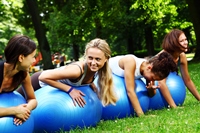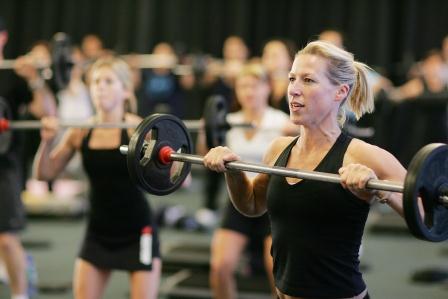1. Your Chest
One of the most common weight room stereotypes: That pecs are a “guy thing.” Women naturally have a smaller ratio of muscle-to-fat in their chests compared with men. Unfortunately, this means that many women get frustrated with chest-strengthening exercises and either forgo them entirely or do them with improper form, according to Montenegro.
Think about it: How many times have you collapsed mid push-up and thought, “I’m strong! Why can’t I do this?” It’s because most women actually have to train in order to do what, for men, may seem easy.

Strengthen It: The Eccentric Bench Press and Push-Up
To master this move, prepare to slow down and put the emphasis on the eccentric (downward) motion rather than the press upwards. (You can even have someone else raise the barbell for you.) This actually works your chest more intensely than a standard bench press, since your muscles get stronger moving eccentrically than concentrically. Plus, it trains your underlying core muscles (more on that later), and your triceps, which are naturally small and tend to tucker out even before your larger chest muscles do.
How to: Lay flat on a bench, holding a barbell just above your chest, elbows positioned near the sides of your body. Your palms should be facing up, hands chest-width apart. Press the barbell directly upwards until arms are fully extended (or have a spotter help you lift it), and then slowly lower it back down to your chest for a count of four to five seconds. Perform three to four sets of eight to 10 reps each week.
For a bodyweight-only option, push-ups are another complex movement that will hit the chest muscles (in addition to the shoulders, arms and core). Complete the standard variation, or try incline (hands elevated) and decline (feet elevated), Montenegro suggests. That will help you train multiple areas within your pectoralis muscles. Once a week, complete three to four sets of as many reps of as you can manage with proper form.
2. Your Hamstrings
Many women are all about leg extensions, squats, lunges — and, of course, spinning —when they work out. And while they can all help strengthen your lower body, they emphasize the quadriceps more than they do the hammies, Montenegro says. “Women’s quadriceps actually tend to be about twice as strong as their hamstrings,” she says. Add in high heels and things can get more uneven; wearing pumps transfers your body weight forward, so your quadriceps work harder with every step.
This imbalance can make women vulnerable to knee injuries — especially since their knees are already under a lot of pressure. Women’s pelvises are naturally wider than men’s, meaning that the femur, which attaches to the pelvis and knee, doesn’t go straight up-and-down, but slants so that body forms an “X” shape, she explains. Add that to the fact that monthly spikes in your estrogen levels can make joints more flexible, and there’s no option but to strengthen your hammies in order to protect your knees.

Strengthen It: The Dumbbell Single-Leg Deadlift
“One of the best exercise to work the hamstrings is the dumbbell single-leg deadlift,” Montenegro says. As you progress, you can perform barbell deadlifts to further train your hamstrings while also strengthening your lower back and glutes.
How to: Stand with feet together, knees slightly bent, holding a dumbbell in the right hand. Keeping your back flat, begin to lean forward, hinging at the hip. Squeeze your left glute and hamstring and extend your right leg straight out behind you for balance. Your right arm will be perpendicular to your right leg. Return to starting position, switch sides. Shoot for three to four sets of eight reps on each side every week.
3. Your Core
Women’s bodies are built to be able to squeeze out a baby, meaning that the ligaments and tendons in your hips are more elastic and loose than those of the average guy, Montenegro says. Plus, ladies have a larger lumbar (low back) curve. So, to maintain correct posture, you need a killer core.
Unfortunately, most women don’t have the strong midsection they need. While there may be plenty of “core-sculpting” of the (look at me!) abdominal muscles (often through crunch and crunch variations), these movements don’t give their deep, stabilizing muscles the attention they need, she says. Those internal muscles are what is going to keep you upright and help you power through everything from running to kickboxing.

Strengthen It: The Plank (left) and the Bird-Dog (right)
Your core is so important, we’ve got two moves for you to try. Plank it up with side and front variations of the core-strengthening exercise, or try the bird-dog, which is awesome for your back, Montenegro says.
Plank How-to: For the plank, support yourself on your forearms, keeping your shoulders over your elbows, knees up, butt down and back flat. Want to hit all areas of your midsection? Add in the side plank, where you’ll support yourself on one forearm, body angled to the side and knees lifted. With your chest open, raise your other forearm raised straight above your body. Once per week, complete each plank variation three times, holding the position for 30 seconds and working up to 60.
Article including pictures sourced from: http://dailyburn.com/life/fitness/strength-training-for-women-neglected-muscles/




 Congratulations to Josh Graves who is our New Fitness Trainee, he is not afraid of hard work and is very good with his hands… Josh recently finished a 4 year apprenticeship as a Furniture and Cabinet Maker with local joinery Infracraft but has always wanted to pursue his true passion of fitness. He says that helping people experience what life has to offer when they’re are in peak health is what motivates him to get up each morning. Josh has been a member in the club since 2010 and loves strength training. He can’t wait to broaden his horizons in the industry he is passionate about though, so look out for him over the next few weeks participating in zumba, balance and baby boomer classes among others.
Congratulations to Josh Graves who is our New Fitness Trainee, he is not afraid of hard work and is very good with his hands… Josh recently finished a 4 year apprenticeship as a Furniture and Cabinet Maker with local joinery Infracraft but has always wanted to pursue his true passion of fitness. He says that helping people experience what life has to offer when they’re are in peak health is what motivates him to get up each morning. Josh has been a member in the club since 2010 and loves strength training. He can’t wait to broaden his horizons in the industry he is passionate about though, so look out for him over the next few weeks participating in zumba, balance and baby boomer classes among others.

 or
or 







 The fight for the Champions Trophy & FREE Membership is on like Donkey Kong in the 2014 Members NRL Tipping Competition. After only 8 rounds and with still plenty more remaining, the current top 5 tippers are killing it!
The fight for the Champions Trophy & FREE Membership is on like Donkey Kong in the 2014 Members NRL Tipping Competition. After only 8 rounds and with still plenty more remaining, the current top 5 tippers are killing it!



